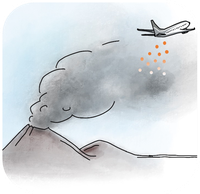Overview
Stratospheric Aerosol Injection is a technique which aims at increasing the backscattering of solar radiation directly back into the space to cool Earth's climate by injecting Aerosols in the Earth’s stratosphere.
The quantity and nature of the aerosols in Earth's stratosphere determine the degree of cooling or warming and affect the course of important chemical processes in the stratosphere. In ACtIon4Cooling we will study the impacts of aerosols in the stratosphere, related to Stratospheric Aerosol Injection (SAI), using natural analogues of volcanic aerosols injected in the stratosphere after volcanic eruptions. Detailed measurements for the derivation of their microphysical and optical properties is essential for the quantification of their radiative effect, as well as model evaluation and understanding of the processes that take place.

Stratospheric Aerosol Injection - the benefits and options
There is a body of evidence that suggests SAI has potential as an effective technique in reversing the Earth’s warming rapidly. Satellite observations after major volcanic eruptions have shown a global cooling impact following the release of large concentrations of reflective particles into the lower stratosphere. Due to their chemical composition, the net radiative effect of volcanic aerosols is negative because they more effectively scatter shortwave solar radiation in comparison to absorbing longwave terrestrial radiation.
The addition of sulphate particles into the stratosphere after a volcanic eruption provides a natural analogue for Solar Radiation Modification (SRM) deployment: The Mount Pinatubo eruption, in 1991, injected approximately 20 million tons of SO2 into the stratosphere - as measured by the Total Ozone Mapping Spectrometer (TOMS) -and the SO2 cloud remained in the atmosphere for weeks (Bluth et al., 1992). The global annual-mean cooling in the following two years was quantified at 0.3-0.5°C and coincided with a reduction of the global water vapour concentrations. This demonstrated that the water vapour feedback in the climate models is crucial for making climate change projections (Soden et al., 2002).
For the deployment of a SAI approach, a scaling up of a global mean temperature reduction of about 1-2°C would require the annual continuous injection rates of several million tons of sulphur dioxide equivalent to the injection of SO2 concentrations after Mount Pinatubo volcanic eruption.
Currently, the technology to achieve injection aerosol precursors at a predefined altitude of the stratosphere is lacking. There are however a few climate geoengineering proposals (Vaughan and Lenton, 2011) and review studies on capabilities and costs on such an SRM deployment (Smith and Wagner, 2018).
Although the injection of volcanic aerosols is widely used as the natural analogue of SAI, it may not be the optimum solution due to its adverse effects, such as stratospheric ozone depletion. For this reason, the ACtIon4Cooling project will investigate simulated cases of SAI, with varying microphysical and optical properties. The size distributions will be similar to volcanic aerosols, but the project will take into account larger and smaller particles, to investigate the effects of quicker or slower deposition of the particles, respectively. The refractive index will be that of calcite particles, which have been reported to not have an effect on ozone depletion (e.g. Tilmes et al., 2022) and will have a non-spherical (spheroidal) shape.
The ACtIon4Cooling project will investigate the eruptions of Mnt. Pinatubo, Calbuco, Eyjafjallajökull and Mnt. Etna, using space and ground-based remote sensing observations to derive the microphysical and optical properties of volcanic particles injected in the stratosphere. Special focus will be given to the use of lidar observations (from space and ground), along with their synergy with passive remote sensing observations, to acquire valuable information on particle injection height, along with their microphysical and optical properties. The observations will be acquired at variable locations (i.e. Iceland, Ruang/Indonesia, Chile, Philippines) and seasons (i.e. winter, spring and summer), from a large period of time, as this is available from the observational datasets for each eruption case.
References
Bluth, G. J. S., Doiron, S. D., Schnetzler, C. C., Krueger, A. J. and Walter, L. S. Global tracking of the SO 2 clouds from the June1991 Mount Pinatubo eruptions. Geophysical Research Letters. 19: 151–154, https://doi.org/10.1029/91GL02792,1992.
Soden BJ, Wetherald RT, Stenchikov GL, Robock A. Global cooling after the eruption of Mount Pinatubo: a test of climate feedback by water vapor. Science. Apr 26;296(5568):727-30, https://doi.org/10.1126/science.296.5568.727, PMID: 11976452, 2002.
Vaughan, N.E., Lenton, T.M. A review of climate geoengineering proposals. Climatic Change 109, 745–790. https://doi.org/10.1007/s10584-011-0027-7, 2011.
Tilmes, S., Visioni, D., Jones, A., Haywood, J., Séférian, R., Nabat, P., Boucher, O., Bednarz, E. M., and Niemeier, U.: Stratospheric ozone response to sulfate aerosol and solar dimming climate interventions based on the G6 Geoengineering Model Intercomparison Project (GeoMIP) simulations, Atmos. Chem. Phys., 22, 4557–4579, https://doi.org/10.5194/acp-22-4557-2022, 2022 a.

